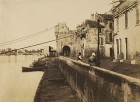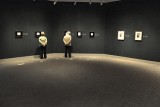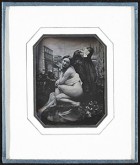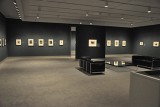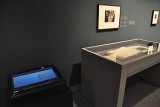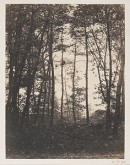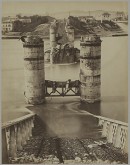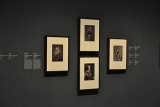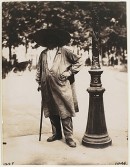The browser will either open the file, download it, or display a dialog.
Nineteenth-Century French Photographs from the National Gallery of Canada
National Gallery of Canada, Ottawa
5 February – 16 May 2010
Art Gallery of Alberta, Edmonton
24 June – 10 October 2011
Catalogue
James Borcoman, Nineteenth-Century French Photographs from the National Gallery of Canada. Ottawa: National Gallery of Canada, 2010.
Issued in French as Photographies françaises du XIX siècle du Musée des beaux-arts du Canada.
168 pp., essay, catalogue and notes
250 illustrations, 100 in color
$49.00 Can. / $55.00 U.S.
ISBN: 9780888848734
Reflecting on his encounter with one of Auguste Salzmann's photographs of Jerusalem taken in 1854, Roland Barthes recalls an experience with time that differed from his experience with the temporality of lived experience. Salzmann's photograph of a road in Jerusalem is only a picture of a dusty place, Barthes says, "nothing but stony ground, olive trees." And yet this picture is the basis for a highly affective experience that leads Barthes to question how the photograph influences our understanding of lived and historical time. Barthes finds that the photograph locates him in a temporal conjugation that is difficult to resolve: ". . . three tenses dizzy my consciousness: my present, the time of Jesus, and that of the photographer, all this under the instance of 'reality.'"[1] The photograph leads Barthes to locate himself in this view of time as history, and of history as a reality verified by photography. Aside from the events a photograph may help to narrate, and aside from the subjective ("hedonistic" Barthes calls them) pleasures each of us might experience as our eyes peruse photographic images, perhaps the only consistent characteristic all photographs share is one that, in its essence, can only be grasped negatively. That which appears in historical photographs is no longer, Barthes argues in Camera Lucida, a little book that is itself a meditation on the death of his mother, memory and irrevocable passage. What the photographic image makes visible, Barthes concludes, is the withdrawal of time as lived experience.[2]
The photographic image weakens the temporal qualities of lived experience by fixing a selected moment and suspending it in an apparently objective manner. What remains is a material object that makes an important contribution to how we imagine the past and the present, and to how we "configure" these into a story. The twofold nature of photography as both witness to a transient reality and as material evidence has been a subject of inquiry since its invention (fig. 1). As Geoffrey Batchen notes, the inventors of the medium observed that photography is a practice that "both reflects and constitutes its object, that undoes the distinction between copy and original, that partakes equally in the realms of nature and culture."[3] On the one hand, photography gives the impression that nature and the world have impressed themselves on the surface of the image. The photograph makes temporal difference visible, acting as "fugitive testimony" to a sometimes distant past. The moment from the past that appears in the photograph is constituted as one "real" moment among others.
While what we see in the photographic image has (had, will have had) an undeniable reality, this reality is temporally and spatially different from our own. On the other hand, then, photography emphasizes the difference between the lived experience it records and the historical record it helps to inscribe. Walter Benjamin sees in the first photographs a tension between the wonderment of man's first encounter with the camera and the "unspoken" objection that these machines will never be able to apprehend the human countenance.[4] We wonder at the different worlds we see in nineteenth-century photographs because of their potential similarity to our own, but what we see is a time that has withdrawn from the present and become fixed and suspended in configurations of silver. We marvel at the details, textures, and tones of photographic images, and in addition to the temporal difference they introduce, we become aware of their material difference from the world they show. We look for evidence and points of familiarity while being struck by the very idea that we are (impossibly!) seeing a world the same way it was seen by the photographer. As we observe the historical photograph, we witness a world that was, and in which we have yet to come to be. Photographs are visual illustrations of absence and temporal difference; they are remainders of the past and reminders that the present moment will pass into what will come to be called history.
A selection of Salzmann's photographs of Jerusalem is among a selection now on view in Nineteenth Century French Photographs from the National Gallery of Canada, an exhibition that showcases the National Gallery of Canada's (NGC) extensive collection of historical photographs.[5] The exhibition runs at the NGC in Ottawa from February 5to May 16, 2010 and at the Art Gallery of Alberta in Edmonton from June 24to October 10, 2011 (fig. 2). James Borcoman established the museum's extensive collection of historical photographs during his tenure as curator of photography from 1967 to 1994 and has returned as curator emeritus for this exhibition. The NGC's collection of historical photographs was established before the growth in commercial interest in historical photographs in the 1980s through both an economical acquisition strategy and significant donations. This exhibit is the second in a series designed to highlight these collections.
The number of iconic photographs one encounters among the 117 exhibited here is notable. Each of the five rooms includes images that have become monuments to a visual sensibility and inquisitiveness now associated with the nineteenth-century French contributions to the medium. The exhibition unfolds chronologically, a convention that has organized the study of visual art since the late eighteenth century. In the case of nineteenth-century French photography, the historical narrative is paralleled by an unfolding of significant topical and technical developments. The first three rooms, in particular, give the visitor a glimpse into the intense technical and visual inquiries evident in mid-nineteenth century French daguerreotypes and photographs. In the final selection of photographs, and with those by Eugène Atget in particular, we can detect a shift away from the early enthusiasm for invention and exploration (both technical and spatial) and a rising interest in visual and psychological experimentation, which is characteristic of modernist aesthetics.
The first room includes a small selection of daguerreotypes presented under lighting that is specially designed to emphasize the silvery and highly reflective disposition of these objects (fig. 3). The light reflects onto the gallery floor, creating a dramatic counterpart to the objects on the wall and maximizing the conditions that will allow the viewer to appreciate the full tonal range in the image. Daguerreotypes are unique, direct positive images recorded on light-sensitive pewter, and later copper plates. Following an important collaboration with Nicéphore Niépce, Louis Jacques Mandé Daguerre gave the process his name, and the process was announced publicly by scientist and politician François Arago in 1839. It became immediately popular and accessible to amateurs and accomplished artists alike. The examples exhibited here are given ample space and are framed with wide, black velvety matting that recalls the practice of keeping daguerreotypes in small and ornate carrying cases as personal memorial and commemorative objects. These daguerreotypes have been framed as fine art objects and are displayed in a manner that fosters a view of these objects as precious and iconic.
We might contrast the discrete and affective experience provided by this approach to exhibiting daguerreotypes with an approach that accounts for the popularity, volume, and relative accessibility of these objects.[6] The Art Gallery of Ontario's approach to exhibiting daguerreotypes, for example, emphasizes the wide-ranging impact these objects had on nineteenth-century popular visual culture by exhibiting a variety of samples in differing sizes and formats within a single long display cabinet. Unlike the NGC, the AGO has galleries that are permanently dedicated to photography. In addition to a variety of daguerreotypes, the AGO includes examples of stereoscopic images the visitor can handle and view through a stereoscope, as well as a rotating selection of historical and contemporary photographs. This approach to exhibiting photographs suggests the importance of considering its impact on visual and mass culture in the institutional context, and presents a challenge to how established practices of fine art exhibition frame their objects.
Théodore Maurisset's 1840 lithograph La Daguerréotypemanie hangs in the exhibition's entry room and is a well-known example of a satirical view of the frenzied and popular interest that had accompanied the introduction of the daguerreotype. This picture demonstrates photography's popularity and the impact it had on the experience of looking at and inventing visual representations in the space of one year. Charles Baudelaire took a less satirical, but decidedly negative view of photography in his 1859 Salon essay, in which he argued that the medium was simply an industrial development that was impoverishing both the genius of the artist and the public's ability to recognize the unique qualities of artistic achievement. Baudelaire argued that photography excels at factual exactitude and at restoring to the tourist's eye "the precision that his memory may lack." Just as printing and shorthand are the vehicles for literature, photography should remain a servant or tool of the artist, and be kept from encroaching upon the domain of the impalpable and the imaginary.[7] In an 1862 lithograph, Honoré Daumier lampoons the photographer Nadar who, with the aid of a hot-air balloon, literally floats above a sea of photography studios and suppliers, thereby, as the caption says, "élevant la Photographie à la haut eur de l'Art" (raising photography to the level of art). Directly related to these reactions is the question of the impact the photographic image has had on how we imagine ourselves, and our place in society and history.
In addition to the everyday uses and applications of daguerreotypes and photographs, and despite the fear that "the results of a material science would be confused by artist and public alike with the beautiful,"[8] both the daguerreotype and the photograph have been given an important place in the domain of fine art. And while this place may be in part the product of museum practices that define and redefine the histories and meanings of material visual objects, there is ample evidence that early practitioners were concerned with investigating the relationship between this new "material science" and the fine arts. Jean-Gabriel Eynard's Self Portrait with Wife Under the Trees (c. 1843) is a beautifully composed study that highlights the details and qualities particular to the often small daguerreotypes. Most of the 12 x 16.1 cm image is filled with sunlit leaves that appear on the plate as a sea of luminous and variegated contrasts. Portraits such as Priest by the unknown Depaulis (1845) and the nude Académie (1845; fig. 4) by Félix-Jacques-Antoine Moulin render individuals with realism, or more precisely exactitude, that was incomparable at the time. These images turn to compositional and symbolic conventions that had been established by art academies and that would be recognized by the public. Yet the daguerreotype also introduces an image that seems to reduce or remove the role of artistic invention, and this introduction provided what was perhaps photography's most significant contribution to a critical thinking about visual art. In Edgar Allan Poe's assessment, the daguerreotype exceeded the arts of representation in presenting an "absolute truth" and a "perfect identity of aspect." [9] These images initiated questions regarding the relationship between the fine arts and visual culture more broadly, and investigations into the nature and limits of representation by painters like Édouard Manet and Edgar Degas, who were both influenced by the cropping and points of view offered by photography. The few fine examples included here provide a subtle suggestion of the broad impact these objects had on both art and culture. The daguerreotypes are reproduced to scale in the catalogue, and are complemented by two or more images that have thematic, compositional, or authorial associations.
While the shift to paper-based photographic processes did not fully replace the daguerreotype until the late 1850s, several examples of early paper innovations are exhibited alongside the daguerreotypes in this first room. Photographic images recorded on paper do not have the precise detail and luminosity that characterize the daguerreotype. Paper adds softness to edges, greater tonal variation, and the effect of grain in the image. Before the suspension of silvers in a medium that sat on the paper's surface, the photographic image took shape within the paper's fibrous weave, leaving a matte surface that all but eliminates the reflective effects of the daguerreotype. Hippolyte Bayard expanded upon the investigations that had begun in the late 1830s, creating a process that resulted in negative-toned images on paper, and positive paper prints resulting from direct, in-camera exposure. However, it was William Henry Fox Talbot's waxed paper negative and sensitized paper process that would contribute most of all to the subsequent achievements in photography. As Borcoman observes, Talbot's presence in France in the 1840s may have had a greater impact on French photography than has been recognized to date. While the daguerreotypes reference fine art and provide a striking experience with light, Bayard's Horse Dealer's Sign is a detailed image of the unique features of the everyday rendered moderately dramatic through a composition that balances formal interest with contrasts in lighting and tones.
Louis-Désiré Blanquart-Évrard is an important figure in the history of the mass-production of images and texts, and contributed significantly to the development of the commercial and illustrated book industry in the 1830s. By increasing the sensitivity of Talbot's paper negative, Blanquart-Évrard could produce images mechanically that included details that approached those of the daguerreotype and that featured a wide tonal range. Several images attributed to him are included along with Bayard's. Farmyard (before 1853) shows attention to depth, tones, and contrast as well as composition. Both Bayard and Blanquart-Évrard made significant contributions to the innovations and expansion of early photography, and their photographs offer an important if visually very different counterpart to the daguerreotype. In addition to initiating questions about the relationship between fine art and photography, these early examples remind us that photography made it possible for individuals to isolate, re-frame, and represent selected aspects of their world. These gestures are photography's signal contributions to modernity and modernist aesthetics.
The exhibit opens up both spatially and topically in a third, large room that demonstrates the extent of the medium's expansion by the 1860s. Instrumental to this expansion were the commercially and serially published books that, thanks to Blanquart-Évrard, had become staples of French visual culture in the late eighteenth and early nineteenth centuries (fig. 5). In addition to creating new ways of framing and representing the world, photography made it possible for travelers to produce illustrated records of their journeys. The newly industrialized book industry, in turn, offered a popular venue for presenting early travel photography, which offered an objective alternative to etchings and lithographs based on the author's sketches and descriptions. Coinciding with a post-revolutionary climate of industrialization, economic and political expansion, and nationalism, the photographic survey contributed to the creation of ideas of the history and landscapes of home and away that continue to inform our worldview. The NGC has an important collection of photographically illustrated books and two are on exhibit here. The first, volume 2 of Maxime Du Camp's Egypte, Nubie, Palestine et Syrie, (1852), is located in a display cabinet at the entrance to this room, while Félix Bonfils' later Souvenirs d'Orient, Album Pittoresque des sites, villes et ruines de la Terre-Sainte (1878) closes the exhibit. Many of these books were dismembered in the 1980s by private owners and collectors in order to profit from the growing commercial and curatorial attention to historical prints and photographs.[10] Books that do remain intact, such as the examples on view here, often bear traces of age and environmental damage and are fragile. Borcoman notes that the dismemberment of photographically illustrated books has permitted curators to intermittently display objects that are susceptible to deterioration: the metals and minerals that are bound to paper fibers deteriorate with prolonged exposure to light.
This dismemberment resulted in an important loss, however, as these large books are in themselves impressive material objects and examples of the diverse treatment photography was given early in its history. The deteriorating condition of these books contributes another layer to the idea that the passage of time results in irrecoverable loss. The photographs that were tipped into these books were considerably smaller than the book pages themselves, and combined with their conditions, the books that do remain intact will not remain so if they are handled extensively. Exhibiting these books means leaving them within display cabinets and opened to a selected page spread. The displays allow the visitor to gather a sense of the material dimension of these books without compromising or dismembering the books themselves. Framed samples of works by these photographers also are included along with these books.
Du Camp's photographs were often taken in very difficult situations and have come to represent the determination required by the early photographers to accomplish their objectives. Du Camp's experience in North Africa indeed may have led him to abandon photography. However, the images of North Africa and the orient popularized by these and other traveler's photographic records have also become signs of a difference and distance from the western viewer's perspective. Photographs, such as Du Camp's Western Colossus of the Great Temple, Abu Simbel, Nubia, helped to create an image of North Africa as both spatially and temporally distant from the present. The antique ruin presents a double sense of loss: on one hand it is, as Borcoman points out, a "haunting and sad commentary on time and the ephemeral nature of civilizations."[11] Such imagery has a complex place in the expansion of western political and cultural power, and these photographs contribute to the organization of historical, political and cultural knowledge.
A significant technological contribution accompanies the display of these books (fig. 6). Touch-screen computer terminals present a detailed full color scan of the selected page spread that includes mildewed margins along with all the details of the photographs themselves (the books' dimensions were often much greater than those of the photographs they contained). The visitor is able to "turn" the pages of the books, which have been scanned in full, by dragging her finger across the screen. This interactive technology makes a promising contribution to exhibiting photographically illustrated books and other similar objects. These devices offer a clear advantage to the general public and to researchers alike by making the whole series of photographs within these books available for view. One gathers an appreciation of both the number of photographs that were taken (photography has played an important part in establishing volume as a category in the study of the visual culture of modernity) and their consistent quality. While some photographs are familiar, others are new, offering potentially unexplored avenues for research and analysis. An undeniably useful addition to the tools available for exhibiting and accessing historical photographs, it will be necessary to attend to how technologies such as these influence our knowledge of historical photographs, the places, people and objects they represent, and history as such. And in an era of reduced budgets, financial strain, and shrinking revenues it will be important to track whether these kinds of technological innovations are productive research and presentation tools, or whether they become mechanical replacements for accessing and exhibiting real objects.
Photographic expeditions with archaeological and topographical approaches similar to Du Camp's and Bonfils' also occurred within the boundaries of France. The two largest exhibition rooms include many examples of photographs taken for either state-sponsored or individually motivated initiatives. Many early photographers came to photography with some degree of formal artistic training and the examples selected for this exhibit bear evidence of this influence. Charles Nègre studied with Paul Delaroche and later J.-A.-D. Ingres, academic painters that led the photographer to bring a strong conceptual and technical vision to his practice. The NGC's print of Nègre's Chimney Sweeps Walking (1851) is one of only two known to exist that was signed by Nègre.[12] A detail of this photograph is on the cover of the exhibition catalogue. Nègre used photography to study motion, but unlike Eadweard Muybridge's innovations that captured a sequence of interconnected physical movements, this photograph is composed to create an almost painterly effect of motion. The photographer has added shadows and lightened his negative, resulting in a dynamic paper print of a popular contemporary vision of the everyday street scene. Beyond this iconic image, however, Nègre was a prolific photographer. A significant number of his photographs line a wall in one of the exhibition's larger rooms, and the catalogue includes twenty illustrations.
Prosper Mérimée sent five photographers on a Mission Héliographique to different provinces in France in 1851 to record indigenous monuments, vernacular and secular architecture, and architectural ruins. This project continued the post-revolutionary search for regional, as opposed to Greco-Roman, roots and employed photographers, such as Édouard Baldus, Bayard, Gustave le Grey, Henri Le Secq, and Auguste Mestral. Together they produced a highly accomplished visual inventory of France that supported the ideals of the post-revolutionary nation. Each photographer is represented here. While Le Secq's attention to the sculptural and architectural details of Chartres, Reims, and Strasbourg cathedrals earned him a reputation as an architectural photographer, his attention to the qualities and strengths of the medium is visible in exposures that give the stone surfaces texture and depth. In the case of the photolithograph Chartres (c. 1851), Le Secq isolated a sculpture of an angel holding a sundial. Archaeological in its attempt to bring to light aspects of the cathedral that may otherwise remain unseen, and romantic in its dramatic use of photographic tones and contrast, the sculpture casts shadows on the supporting stone wall that suggests "the speed of the angel's movement as it travels through time."[13] If Le Secq uses photography to give life to stone, Baldus's view of Amiens cathedral (c. 1855) emphasizes the monumental presence the cathedral exercises over the town that sits at its feet through an elevated and expansive point of view.
Le Gray, who also studied with Delaroche, used photography to explore topics and places that had become popular with plein-air painters, and the role of landscape in early French photography is evident in the fourth gallery Study of Trees, Fontainebleau (1855, albumen silver print) shows Le Gray working with wet-plate, collodion glass negatives printed onto paper prepared with an albumen-silver nitrate solution. Collodion negatives render greater detail than paper negatives and do not deteriorate through multiple exposures to light. The remarkable seascape Great Wave, Sète (1857, albumen silver print) is a meticulously rendered composite image made from two glass plate negatives printed onto the same paper at different times. This scene reveals an artist's eye for dramatic lighting and a romantic interest in emphasizing the forces of nature. Eugène Cuvelier followed Le Gray and emphasized the drama and force of nature in his photographs of Fontainebleau, occasionally contrasting this with traces of human passage (fig. 7). Several photographs by John Beasly Greene, born in France to American parents, similarly demonstrate a gradual turning away from precise archaeological photographs and towards a dramatic picturing of landscape. Boat in Harbour, Cherchell, Algeria (1853-56) is marked by a strong and low horizon line and a vast, overexposed sky that intensifies the contrasts, tones, and composition of the harbour and foreground that make up the lower third of the image.
While Le Gray received state commissions to document military maneuvers (included here is the atmospheric French Military Maneuvers, Camp de Chalons: The Guard behind a Breastwork (1857)), Jules Andrieu's series, Disasters of the War, had commercial goals. This record of the effects that the Franco-Prussian War and the Commune had on the landscape and architecture of Paris between 1870 and 1872 was ultimately not a financial success (fig. 8). Alisa Luxenberg suggests that Andrieu refrained from using the word "ruin" due to associations with Denis Diderot and classical aesthetics. The photographer may have thought that "disaster" would have a broader, popular appeal, and "Disasters of the War" may also have been an attempt on Andrieu's part to link Napoleon III's disastrous 1870 war with Prussia and the discontent among workers in Paris with Francisco Goya's illustrations of the French invasion of Spain in 1807. Disasters of War, which shows the effects this invasion had on the lives of Spaniards, was published posthumously in 1863.[14]Pont d'Argenteuil and Saint Cloud after the Armistice opens the final gallery and shows destroyed infrastructure and bombed-out buildings. As photographs, they demonstrate with great detail the tangible effects these conflicts had on Paris. However, despite the photographer's strategic use of "disaster" instead of "ruin," his photographs emphasize the monumentality of effect, suggesting that Andrieu had imagined an audience "more interested in aesthetics than facts, concerned with memories more than ideologies."[15]
The variety of technical developments that characterize early photography were nowhere as extensive as they were in mid-nineteenth century France. From the opening room, the exhibition includes clear summaries of these developments and accessible descriptions of the techniques involved, and the catalogue expands upon them in equally informative and accessible terms. While innovation may have competed with art as a motivation for early photographers, commerce was never far from the fray. Louis-Auguste Bisson and Auguste-Rosalie Bisson learned their craft in their father's daguerreotype studio in the 1840s, and ran their own successful printing house from 1852 to 1863. Three albumen silver prints of Mont Blanc are on view in the final gallery and show both a high degree of skill and detail, as well as dramatic and striking compositional effects. Like most landscape photographs from this time, these prints were made from glass negatives that had been sensitized and exposed by the photographer on site. In a distinctly modern manner, the mountains have been isolated from or cropped out of the landscape. This approach emphasizes the textures, contrasts, and monumentality of these natural formations in a way that foreshadows photography's later interest in formal abstraction.
By the late 1860s a large number of early practitioners had given up photography while others turned the increasingly rapid and practical processes to their commercial advantage. Félix Bonfils founded the Maison Bonfils in Beirut in 1868 to produce views and portraits for travelers. His own photographs are accomplished: Temple Portico, Esna, Egypt (before 1878) is a detailed architectural view that emphasizes the size of the ruins, the texture of the stone, and the strength of the sun. However, Bonfils and others have been criticized for their inclusion of sleeping or seated locals in their compositions, as we see in Temple Portico. Nissan Perez argues that such compositions contributed to a view of the orient as a place and a set of people of infantile simplicity. Photography became less innovative in these conditions, sometimes "to the point of Kitsch."[16] If the presence of Du Camp's servant sitting on the head of the Abu Simbel colossus emphasizes scale, a photograph such as Bonfils' Sculpted Capital, Palmyra (not included in this exhibit) is an extreme example of infantilizing the orient by showing a young local boy dozing atop the displaced capital in the desert sun. These examples, along with photographic expeditions that documented colonial expansion, foreign wars, and cultural differences around the globe, ensure that historical photographs will remain open to critical attention from various methodological perspectives.[17]
The archaeologist Pierre Trémaux followed the daguerreotypists who had travelled up the Nile in the 1840s and used a remarkable mix of printing processes to record and illustrate his Voyages au Soudan oriental and Exploration archaéologique en Asie mineur. These books pursue comparative taxonomies and typological studies that owe as much to Winckelmann's historicism as they do to Darwin's evolutionary theories. While some of Trémaux's salted paper prints faded, other images, no longer bound in book form, clearly show the intersection between photographic technology and other techniques for mechanical reproduction. For example, Turkish Steles, Greek Ephesus (1862-1868) is a photolithograph that renders Arabic inscriptions and sculptural details of two steles in an atmosphere rendered dramatic by the lithographic pen. If this image is a successful combination of techniques, two versions of View of a Court in Tunis – House of the Bey's Minister show how photography was used as a guide for drawing. Trémaux first photographed a courtyard and later produced a lithograph based on this image. Both images are shown side by side in a display case. Trémaux has added detail to the shadows, narrowed the overall perspective of the scene giving it greater depth, and included two people walking through the shadowy courtyard, details that early photography was not able to clearly record.
While Baudelaire held a skeptical, if not entirely pejorative, view of the contributions photography could make to art and culture, Nègre offered a much more dynamic opinion in a manuscript from 1854: "Photography is not a remote and barren art; it is, in fact, a rapid, sure, and uniform means of working, which is at the artist's service, and which can thus reproduce with mathematical precision the form and the effect of objects as well as that poetry which is the immediate result of all harmonious combinations."[18] Étienne Carjat's portrait, Charles Baudelaire (1821-1867) (c. 1863), is included among several other portraits by him in this final room (fig. 9). These portraits were made using the Woodbury-type process and demonstrate the precision of the technique, as well as Carjat's ability to extract or capture certain features of the sitters. Named after Walter Woodbury, an English photographer who photographed extensively abroad and patented the technique late in his career, these images are the result of a photomechanical relief printing that provides constant tonal gradations with no grain and a smooth surface. Traces of this relief give the image depth and form. While Carjat may have taken issue with the poet's disparaging view of photography, he has produced a result that seems to have taken a step towards capturing Baudelaire's countenance, and that the poet himself may have viewed as an "immediate result of harmonious combinations."
If Carjat's Baudelaire suspends the poet in an atemporal, but assured poetic vision, Eugène Atget's Saint Cloud (1907) is an image of rich and brooding tones whose angle shows a turning away from the past and an opening towards the aesthetic spaces of modernist inquiry. Atget introduces a psychological and dramatic dimension that appealed to the avant-gardist movements of the early twentieth century (fig. 10). Atget's striking photographs of Saint Cloud, along with his approach to the streets of Paris, both visualize the harmonious combinations noted by Nègre, and seem to dwell in the negative photographic values of withdrawal and absence that preoccupied Barthes much later. These photographs – and an image like Avenue des Gobelins (1925) in particular, which makes the limit between past and present haunting, unclear, and yet inevitable – announce the next era in photographic investigation. Atget's images hang beside Bonfils' album and its accompanying touch-screen at the end of the exhibition, and bring the narrative of nineteenth-century French photography to a close. The catalogue includes excellent reproductions.
Small in size (26.5 x 20 cm) the catalogue is easy to handle and its matte pages and high-quality, full color reproductions convey the textures and tones of mid-century paper prints. Photographs reproduced in black and white compliment the main catalogue entries and demonstrate a further dimension of the NGC's holdings. The catalogue includes a short essay by Borcoman that surveys the history, techniques, and characteristics of the early French practitioners. Entries are organized alphabetically and include annotations and provenance. Borcoman's entries are informed and concise, and his sensitivity to the poetic aspects of early photographic imagery and the effects photography has had on our imagination of time and place give the catalogue a breadth that makes it both a compelling read and a lasting research resource.
This exhibition may have missed an opportunity to reasonably extend the scope of the material and ideas it presents by neglecting to draw a connection with a set of contemporary photo-based works by Nicolas Baier on display at the same time in the museum's contemporary art galleries.[19] Baier's works address in part the complex place that the reflective, silvery origins of photography continue to have in fine art and practices of visual of representation. The monumental Vanitas (2007-2008) is an assemblage of more than three dozen life-sized photographs of tarnished and peeling silver-backed mirrors (fig. 11). This work is a direct reference to the surfaces of daguerreotypes and the tonal variations that characterize early paper photography. However, Vanitas does not resolve into a clear representation of anything other than what it is: an image of old mirrors that no longer satisfy either their original purpose or the desires of those who used them. While the surfaces of nineteenth-century photographs first reflected and represented a new world, we now encounter them as visual echoes of a world that is becoming increasingly distant. Vanitas interrupts the viewer's gaze at a surface that has lost its illusory and reflective potential and invites us to explore the relationship between the luminous origins of photography, the metaphorical function of images-as-reflections, and our contemporary context and desires. While making connections beyond the historical scope of the materials included in a particular exhibition may introduce questions and issues that do not seem to be immediately relevant, it may also broaden our understanding of the diverse and lasting impact that historical objects have on contemporary knowledge. Photography continues to be the basis of a questioning into the nature of representation and visual mediation of the world that began with its earliest practitioners.
There is a great deal to neglect in an analysis of an exhibition that covers a century's worth of innovation and visual production. At the risk of furthering this neglect, I would like to conclude by returning to another picture by Nègre, Self-Portrait of the Artist (Standing) with his Family, Grasse (c. 1852).[20] It is a small, but striking image that brings Barthes' observations on the constant withdrawal of time from photography together with Nègre's own definition of photography as the result of "harmonious combinations." As Borcoman explains, in this picture Nègre had returned to Grasse, a town in Midi which itself had been built on the ruins (themselves both signs of loss, withdrawal, and the past) of both a sixth-century Greek colony and Roman port. The photographer's family is seated outside. An older woman, who may be the photographer's mother, is seated at the center, and to the right of the image is a young boy held tightly by his mother or aunt, perhaps at the insistence of a photographer who was aware of the impact that the impatience of youth could have on the photographic image. The boy's head has moved slightly and registers as a blurred resistance to the firm hand attempting to hold him still. The family grouping splits towards the center, opening a space for the photographer.
Nègre stands here, turned slightly away from the camera. His left hand rests at his side and his gaze has turned towards his left hand, which is holding a pocket watch. Both head and hands are blurred, a gesture on the part of a photographer aimed perhaps at leaving a trace of resistance – not, perhaps, unlike the resistance to reflection apparent in the tarnished and silver surfaces of Baier's Vanitas – to the inevitable defeat of lived time effected by the photographic image.
Randy Innes, PhD
Instructor, Carleton University; Trent University; School of Photographic Arts: Ottawa
randyinnes[at]gmail.com
This review benefited from a visit to this exhibition and subsequent discussions I had with students from the School of Photographic Arts: Ottawa. I thank my students for their patience, contributions and questions. Janet Whitmore at Nineteenth Century Art Worldwide provided valuable editorial advice.
[1] Roland Barthes, Camera Lucida: Reflections on Photography, trans. Richard Howard (New York: Hill and Wang, 1981) 97.
[2] Barthes, 94.
[3] Geoffrey Batchen, Burning with Desire: The Conception of Photography (Cambridge, MA: The MIT Press, 1997) 69.
[4] Walter Benjamin, The Arcades Project, ed. Rolf Tiedemann, trans. Howard Eiland and Kevin McLaughlin (Cambridge, MA: Harvard University Press, 1999) 678.
[5] My analysis of Auguste Salzmann's 1856 book of photographs, Jérusalem, will appear in a double issue of Art and Religion, Winter 2011.
[6] Upon a recent visit to Gettysburg, PA, I visited a shop that sold relics of the American Civil War. Among objects for sale were dozens of daguerreotype portraits of soldiers. Each image was set in an ornate red velvet case. From its inception the daguerreotype contributed to the confusion among categories of fine art, visual culture, and documentation in modernity that persists today.
[7] Charles Baudelaire, "The Salon of 1859," in The Mirror of Art, trans. Jonathan Mayne (London: Phaidon Press, 1955) 230.
[8] Baudelaire, 231.
[9] Edgar Allan Poe, "The Daguerreotype," in Alexander's Weekly Examiner, January 15, 1840, reprinted in Classic Essays in Photography, ed. Alan Trachtenberg (New Haven: Leete's Island Books, 1980) 37-38.
[10] See among others Abigail Solomon-Godeau, Photography at the Dock: Essays on Photographic History, Institutions and Practices (Minneapolis: University of Minnesota Press, 1991).
[11] James Borcoman, Nineteenth-Century French Photographs from the National Gallery of Canada (Ottawa: National Gallery of Canada, 2010) 66.
[12] Borcoman, 118.
[13] Borcoman, 96.
[14] Thanks to Janet Whitmore for pointing out this connection.
[15] Alisa Luxenberg, "Creating Désastres: Andrieu's Photographs of Urban Ruins in the Paris of 1871," in Art Bulletin LXXX, no. 1 (March 1998), 133-134.
[16] Nissan N. Perez, Focus East: Early Photographers in the Near East (1839-1885) (New York/Jerusalem: Abrams/Domino, 1988), 98.
[17] For example Derek Gregory, "Emperors of the Gaze: Photographic Practices and Productions of Space in Egypt, 1839-1914," in Picturing Place: Photography and the Geographical Imagination, eds. Joan M. Schwartz and James R. Ryan (London: I.B. Tauris, 2003), 195-225. Keri Berg's recent categorization of Salzmann and Du Camp's photographs as "photographic, imperialist narrative[s]" is a greatly reductive approach to this diverse body of images. See Keri A. Berg, "The Imperialist lens: Du Camp, Salzmann and early French photography," in Early Popular Visual Culture, vol. 6, issue 1 (April 2008): 1-17.
[18] Charles Nègre, in James Borcoman, Charles Nègre: 1820-1880 (Ottawa: National Gallery of Canada, 1976).
[19]Nicolas Baier: Pareidolias, National Gallery of Canada, February 12, 2010 to April 24, 2010.
[20] While the NGC would not authorize the reproduction of this image for this review it can be found on Cybermuse, a mirror site for educators and researchers, by searching the title or by clicking here.


